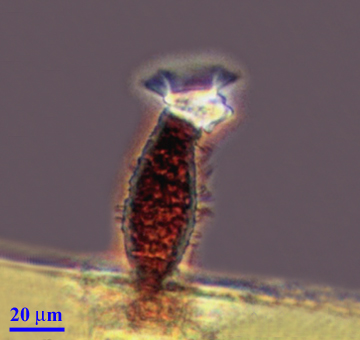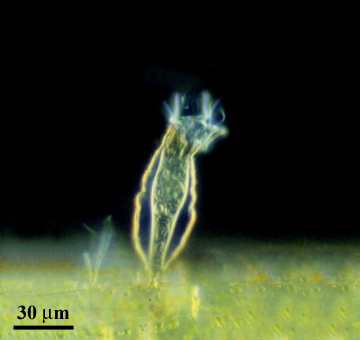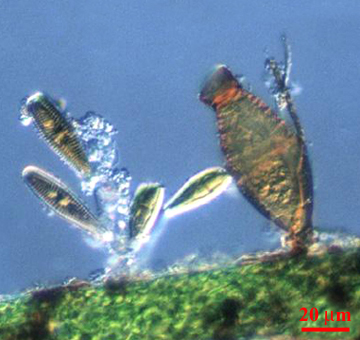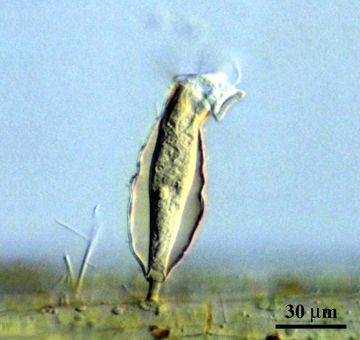Pyxicola “The Box Dweller” |
by
Chitchai Chantangsi, Thailand
![]()
|
|
One of the most common freshwater sessile and solitary protozoa is a ciliate genus Pyxicola. A general feature of the ciliate is its elongated and vase-shaped appearance. The protozoon is always found attached aborally by its stalk, or pedicel, to various kinds of substrata such as organic fragments, a root of minute aquatic plants, a strand of filamentous algae, or even on the body of small aquatic creatures such as tiny crustaceans, etc. The organism is loricate and usually possesses a size approximately 70-120 microns in height and around 25-40 microns at its widest point. This organism takes its name, Pyxicola, from the manner in which the ciliate inhabits a box-like and vase-shaped lorica, or test with a lid-like structure called operculum positioned beneath the border of the cell mouth. This generic name derives from the Greek meaning “Box Dweller”: pyxis, box and cola, inhabitant. |
|
Ordinarily, the bluish-gray translucent cell extends slightly beyond the lorica's orifice. A lorica of Pyxicola is pseudochitinous and has a little constriction subapically adjacent to the anterior oblique opening. In the early stage of life, the younger organism's lorica seems to be colorless, brighter and more transparent than that of the older ones. It lets us see its internal elongate and trumpet-shaped cell body through this structure. Pyxicola adheres by its posterior end to the central and basal inner wall of the lorica. A rather slender and truncated body does not fill completely the test volume, therefore providing a sufficient space for containing a retracted organism (Figure 3). In addition to providing protective strategy, a lorica has varying degrees of colour and the colour appearance itself can be used as a criterion for determining the age of an organism. The darker, the older (Figure 1 and 3). The brighter, the younger (Figure 2 and 4). |
|
|
|
A slightly curved and discoid operculum of the ciliate is similar in consistency to the lorica and functions as a lid. When any stimulation, either chemical or mechanical occurs, the ciliate withdraws its cell deeply into the lorica and the operculum will close the aperture appropriately (Figure 3). The cell retraction in an up and down manner of Pyxicola is an appealing phenomenon for interested microscopists. Generally, Pyxicola is often found with many other individuals on the same habitat as well as together with other epiphytic animalcules like rotifers or epiphytic algae like colonial diatoms (Figure 2). However the organism never forms a true colony and spends its life exclusively as a solitary ciliate. |
|
Apart from having a lorica mounted on a non-contractile pedicel, the organism has a disc-like pad at the base of the stalk—the so-called holdfast organelle—which serves as an affixing structure between the stalk and the habitat (Figure 4). An anterior contractile vacuole helps the organism expel watery media and control osmotic equilibrium. In common with other ciliated protozoa, Pyxicola has both micronucleus and macronucleus. The latter is band-shaped and positioned at the lower part of the cell. This ciliate feeds on organic debris and bacteria. Reproduction of the organism, both asexual and sexual, typically occurs by binary fission and conjugation, respectively. More than 10 species with a range of interspecific variations of the genus have been discovered and studied. However the common morphologically generic character is straightforward. |
|
|
At the moment, this
protozoon is beating its cilia, emerging from its lorica in a freshwater
habitat near you and certainly
looking forward to your observation. |
||
![]()



